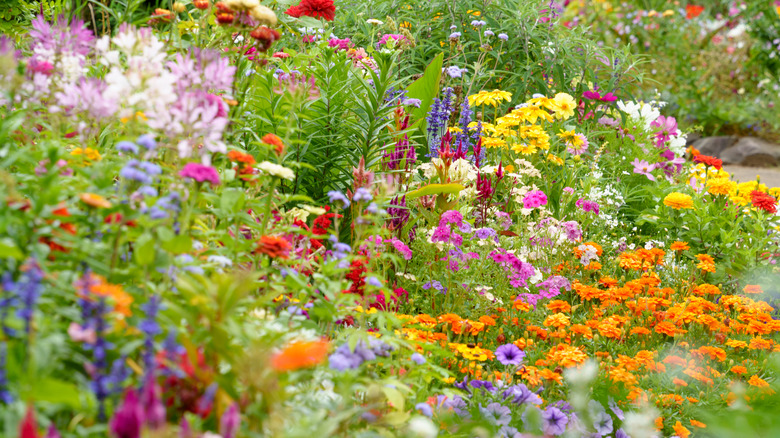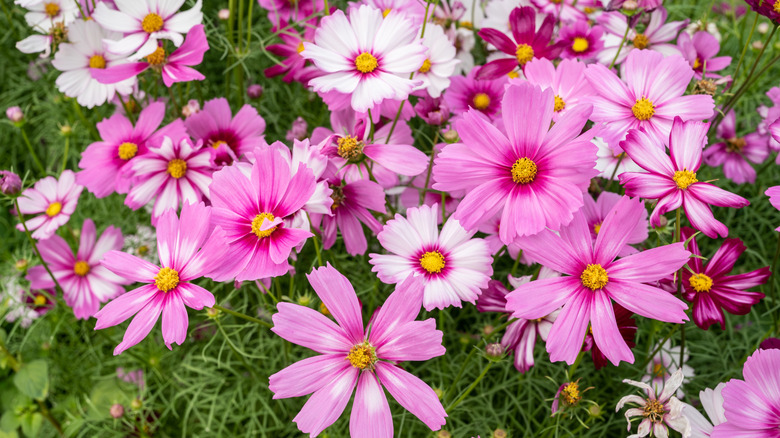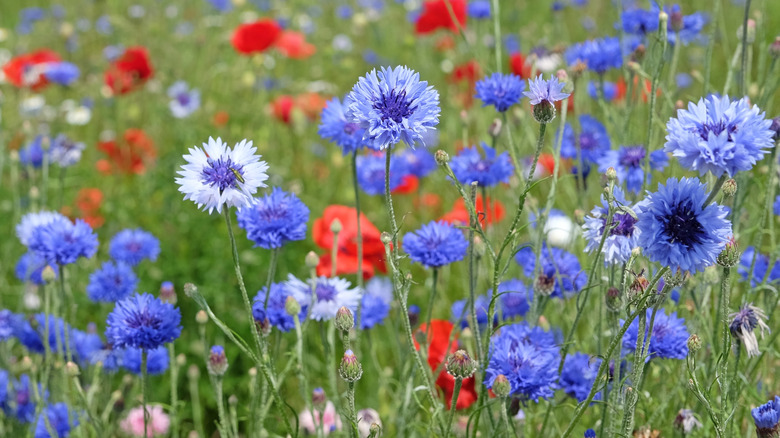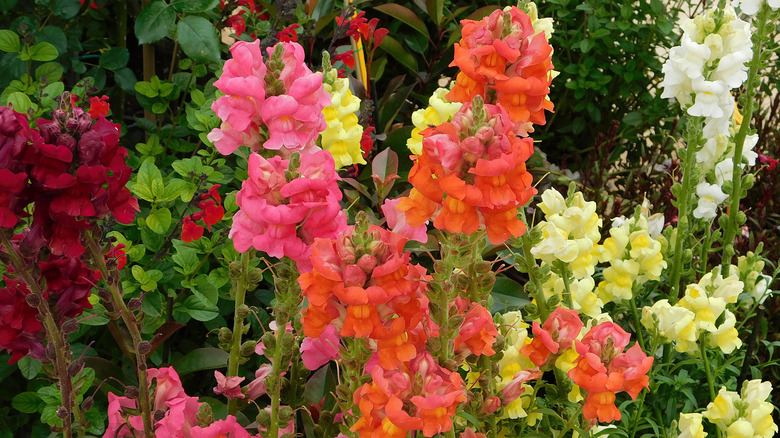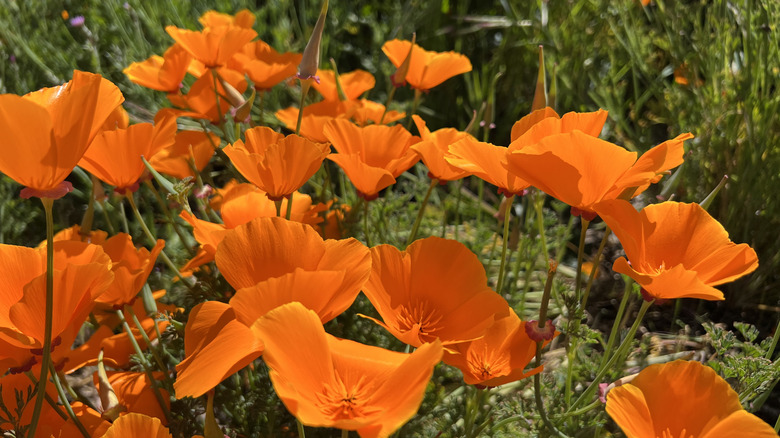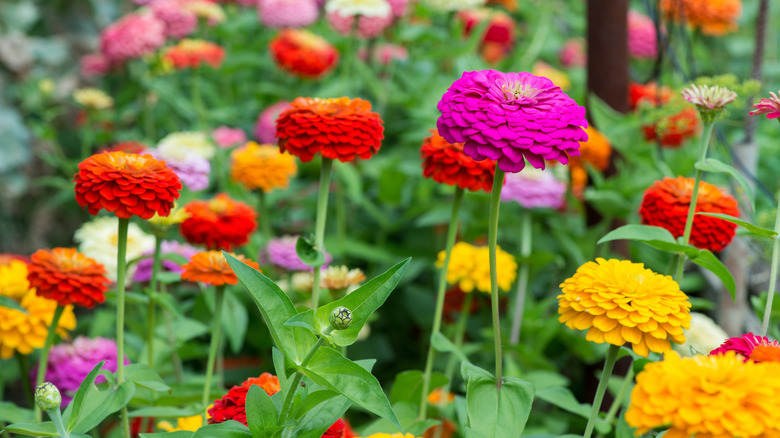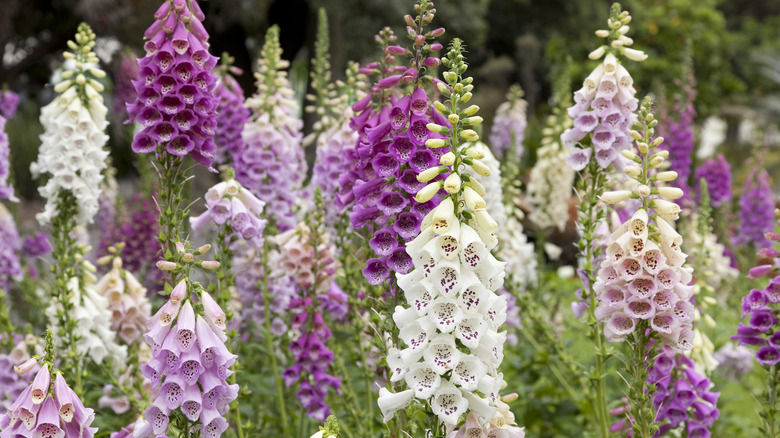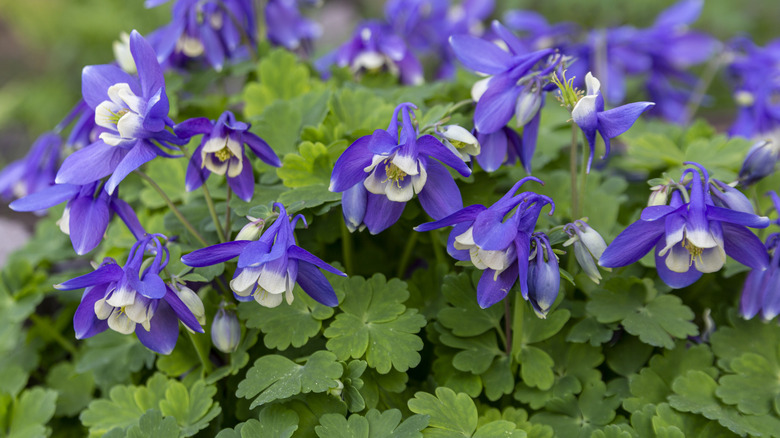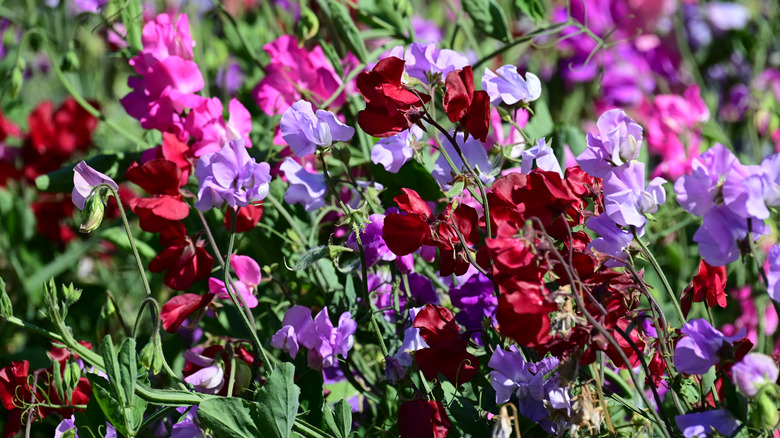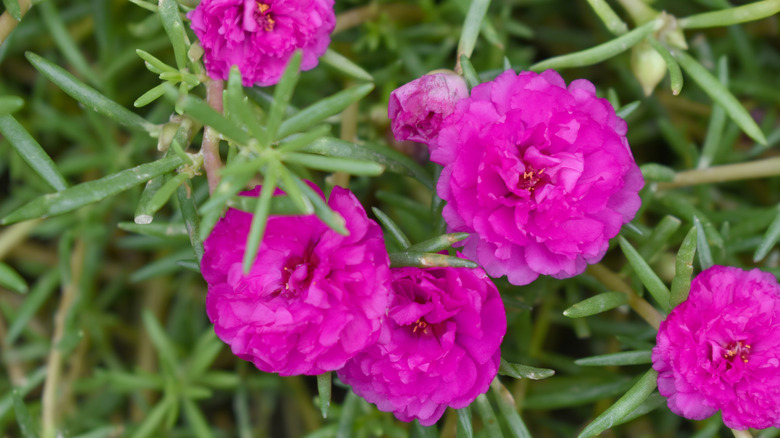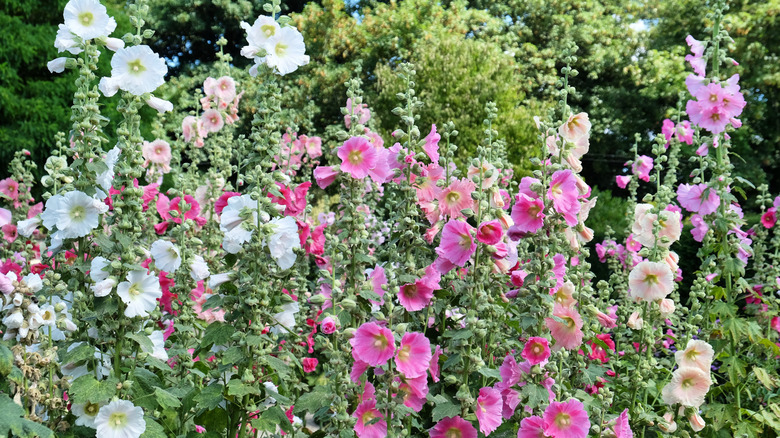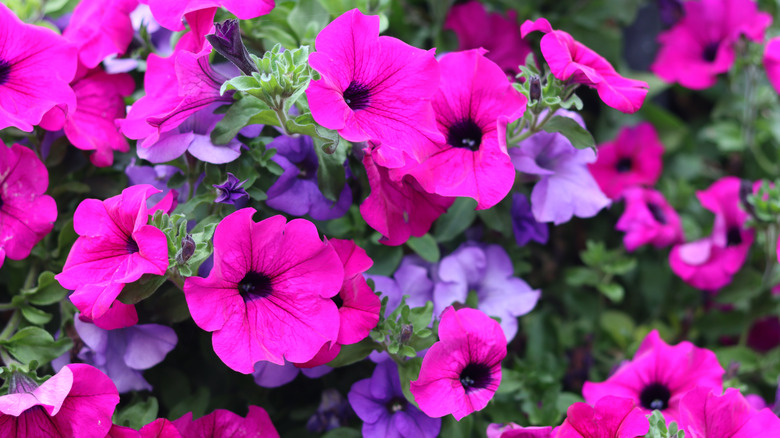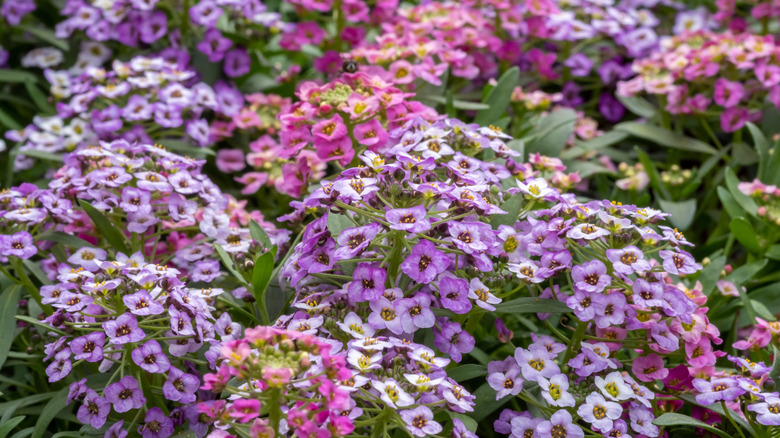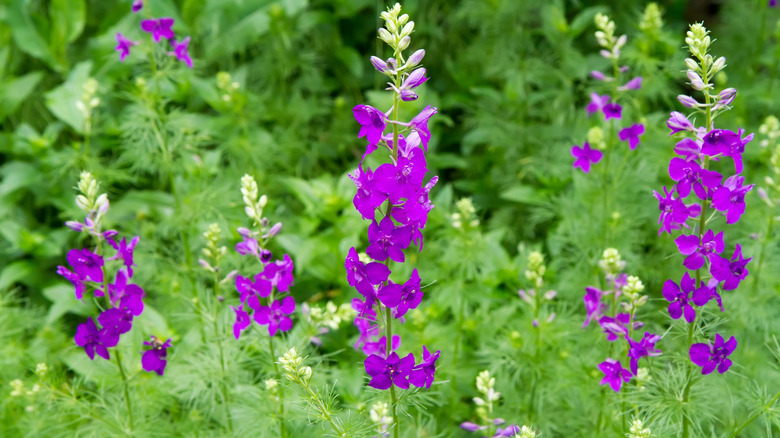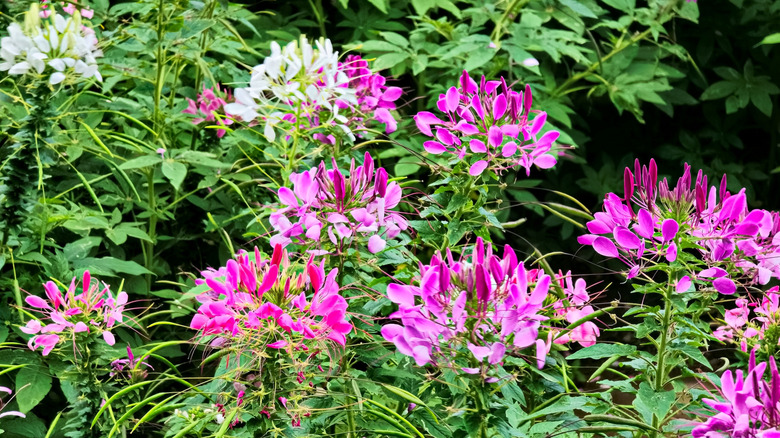17 Self-Seeding Flowers That Effortlessly Fill Your Yard With Color
As a professional gardener, I can confidently say that annuals are an important part of the growing season and the mainstay of a plant nursery's business. They are often planted as supplemental flowers for colder growing zones, where perennials tend to flower for shorter periods of time. Annuals native to warm regions can be grown in northern greenhouses, providing continuous color during the summer months. But luckily, many summer-blooming annuals produce seeds that are cold-hardy enough to germinate into spring seedlings in the garden, which then bloom into summer flowers.
Most gardeners can differentiate between perennials and annuals: the former usually spread via roots, and the latter are grown from seed. But there are some biennials that only flower every other year, but that will reseed themselves, so they give the illusion of being perennials. As well, there are many wonderful annual flowers that reseed in the garden to provide a perennial presence every year. This is not only a happy surprise in the garden, but a real cost-saving measure for gardeners, who get free plants every year!
If you wish, you can gather seeds from late summer annuals to plant the following spring, or let them fall where they may and reseed on their own. Some gardeners employ both methods to allow for the possibility that an especially harsh or cold winter may not allow as many seeds to germinate in spring. You can try this as an experiment to see which method proves most reliable. But in the meantime, here is a list of flowers that have reliably reseeded in my Northeast garden.
Cosmos
Cosmos is a delightful annual that is easily grown from seed and that also reliably reseeds itself in the garden. With delicate daisy-like flowers on tall stems with feathery foliage, these sturdy but ethereal flowers look lovely as a tall presence in a cottage-style garden. These sun-lovers attract plenty of pollinators, especially butterflies. I love the double-petaled 'Bon Bon' cosmos, but there are many colors and variations to enjoy. Collect the seeds in fall as flowers fade, or let them drop, and many will reseed without any help.
Bachelor buttons
Bachelor buttons (Centaurea cyanus) are also known as cornflowers, and "cornflower blue" is named for the brilliant blue variety. But these remarkable annuals come in a huge range of colors and bi-colors, including white, pale to dark blue, purples, pinks, and reds. They reseed very reliably even in cold climates because the seedlings start germinating in early spring. The small plants can also be relocated easily if you want them to grow somewhere other than where the seedlings pop up. These sun-lovers also attract plenty of spring pollinators, making them an important flower for your garden.
Snapdragons
Snapdragons (Antirrhinum majus) are only perennial in very warm zones, but many gardeners have good luck with these colorful flowers reseeding themselves annually. There are a number of forms, from dwarf to very tall, and I have noticed that some of the taller varieties (like 'Rocket' or 'Chantilly') are the most reliable reseeding cultivars. You might even see one of these woody-stemmed snapdragons regenerate the following year if you're lucky, but the seedlings start to pop up as soon as the ground gets warm enough, usually by late May in my Zone 5a garden.
California poppies
California poppies (Eschscholzia californica) are probably the easiest poppies to grow from seed, along with Shirley poppies. Both these varieties are also known to reseed in the garden in sunny spots, but California poppies are especially vigorous volunteers. Once you plant these bright, tangerine-colored flowers, your garden will welcome them back every spring because the seeds like to spread. The seedlings are easy to recognize by their feathery, silvery-green foliage, so you can thin them out or relocate them if they start to grow in too thickly.
Zinnias
Zinnias (Zinnia elegans) come in so many shapes, sizes, and colors, it's difficult for flower enthusiasts to choose a favorite. I'm partial to a recently introduced cultivar, the 'Queen Lime' zinnias, in shades of dusky red, orange, and blush, tinged with lime green for a unique vintage look. Like all zinnias, these will reseed in the garden, and if you slowly collect different varieties, you'll eventually have a large collection of zinnias. Collect the seeds after the first frost, when flowers fade, and plant in spring, or let them go to seed and let Mother Nature (and the birds) do the rest.
Calendula
Also known as pot marigolds, calendula (Calendula officinalis) is an easy-to-grow flower known for its medicinal value and its colorful blooms that brighten the front of the border. The seeds are chunky, curved crescents that are easy to collect and replant, and when planted in the garden or containers, calendula flowers reseed themselves eagerly. Though the most popular colors are yellow and orange, there are some newer hybrids in beautiful shades of cream and pink.
Foxgloves
These well-known cottage garden flowers attract hummingbirds and other pollinators. They are also biennials, like hollyhocks, and will reseed themselves in your garden so that, once they're established, you will have blooms every year. Much like hollyhocks, their leafy bases take up some space, so give those seedlings room to spread out a bit. Foxgloves (Digitalis purpurea) like a rich, well-drained soil and partial shade conditions. They come in a wide range of colors, including white, yellow, peach, pink, magenta, and purple, many with enchanting spots on the inside of their bell-shaped blooms.
Columbines
Columbines (Aquilegia) are one of my favorite perennials that reseed in the garden. If you have different colors and varieties, the seeds often cross-pollinate to produce new hybrids, creating delightful new colors and shapes. These mid-spring bloomers have long-lasting flowers, and once they're done, the heads form slender pods full of small seeds. Columbine seedlings are tiny, and the new plants need time to grow enough to form flowers. I recommend leaving the seedlings intact where they spring up and waiting until the following spring to move them, to give them time to get stronger.
Sweet peas
Sweet peas (Lathyrus odoratus) are vining flowers that love to climb on a fence or trellis or clamber their way over your flower beds. These sweet-smelling flowers come in an array of rainbow colors and are a charming, old-fashioned addition to the vegetable garden or the cottage garden. Although they grow on short vines, the flower stems are between 8 and 12 inches long, making them nice for flower arrangements. You can buy wonderful sweet pea seed mixes bursting with color from almost any online seed vendor.
Forget-me-nots
Who doesn't love these tiny sky-blue flowers in spring? Their airy clusters of tiny daisy-like blooms also come in shades of pink and white. Forget-me-nots (Myosotis sylvatica) reseed freely in the garden, preferring shady spots and moist, rich soil. The clumps are very easily relocated to where you want them. To control them from reseeding too much, just deadhead the stems as the flowers fade and before the seeds form.
Portulaca
Multi-colored portulaca (Portulaca grandiflora) was one of my favorite flowers as a child because my mother always planted them every year in her huge rock garden. These make terrific rock garden plants because the tiny seeds will reseed themselves in crevices and among stones, a perfect environment for the spiky succulent foliage that thrives in hot, sunny weather. Also known as moss rose, this plants is a good annual for tricky spots, like the thin strip next to your driveway or a sloping garden. There are many bold, beautiful color mixes available, like 'Happy Hour,' 'Sundial,' and 'Magic Carpet.'
Love-in-a-mist
Love-in-a-mist (Nigella damascena) is a small, delicate flower, growing less than a foot high, with lovely cool colors and light, feathery foliage. They look beautiful in containers and in the front of your garden border. You can buy seed mixes of various colors, like the blue, pink, and white colors in 'Persian Jewels', or the deep purples and blues of 'Midnight Nigella.' These long-blooming annuals put out attractive seed pods and reseed reliably in the garden.
Hollyhocks
If you have space for these tall, colorful beauties, you should definitely plant hollyhocks (Alcea rosea) in your garden! They are biennial, but once established, they will reseed so you have blooms every year. When the seedlings come up, make sure they're in a spot with enough room for the large base clump of leaves, which can be 12 to 18 inches wide; if they need more space, gently replant them in a better spot. These stately flowers do best in the back of the border with a fence or wall for support in case of heavy wind or weather.
Petunias
Petunias are favorites for container plantings and the front of the summer border, producing copious new flowers all season as long as you keep deadheading them. These colorful flowers are also pretty good at reseeding themselves. For some reason, I tend to find petunias reseeded in spots that don't have much soil, like sidewalk cracks or the edges of walkways, and they also sometimes reseed in containers. Rather than count on them as reliable reseeders, I just act surprised and happy when they come back (and they often do).
Sweet alyssum
Sweet alyssum, true to its name, is a fragrant flower with tiny blooms whose roots form a strong, dense mat that deters weeds. For this reason, and because they attract pollinators, they're often planted in vegetable gardens as companion plants along row edges. Sweet alyssum (Lobularia maritima) also likes to reseed in the garden, so you can rely on it coming back every year. White and purple are the most common colors, but there are pink and apricot varieties. Keep in mind that the bright yellow alyssum known as 'gold dust' is a different plant (Aurinia saxatilis).
Larkspur
An annual type of delphinium, larkspur is a common meadow flower with slender spikes of colorful, delicate flowers. They reseed themselves well and are frequently included in wildflower or meadow flower seed mixes because they're reliable growers that happily multiply over the years. You can purchase many colors of larkspur seeds, from pale pink to dark blue, and they're a gorgeous addition to cottage-style gardens.
Cleomes
Also known as spider flowers, cleomes (Cleome houtteana) are unusual-looking plants with rounded flower heads that include needle-like stems that are actually seed pods. They come in a range of cool two-toned colors, from white to deep purple, with many shades of pink (my favorite is 'Cherry Queen', which has gorgeous petals of pale and hot pink). They grow easily from seed and, in sunny spots, will often reseed themselves yearly. The tiny seeds spread via the wind, so they sometimes end up in odd places like roadsides or construction sites.
